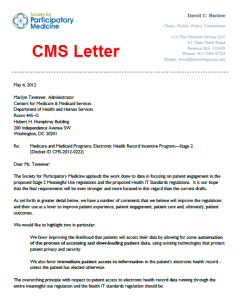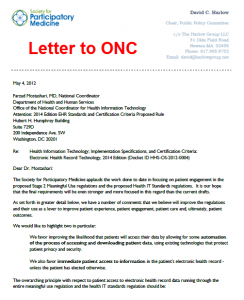Afternoon additions:
- You too can submit your opinion on the official public comment site. They even allow uploading attachments.
- As I just told a friend on Facebook: “How often, before this administration, did Washington make it truly easy for anyone to tell their story, from home? This administration is really open to this, and I have it on close first-hand authority that they actually read every one of these things, and the people in charge making the rules actually do care.”
- Participate!
- At bottom, I listed my personal highlights from these two short letters.
From David Harlow JD MPH, policy chair for our Society for Participatory Medicine:
I’ve uploaded SPM’s comment letters for Meaningful Use Stage 2 regulations, one for the Medicare/Medicaid regulations, one for ONC. Each letter opens like this:
____________
The Society for Participatory Medicine applauds the work done to date in focusing on patient engagement in the proposed Stage 2 Meaningful Use regulations and the proposed Health IT Standards regulations. It is our hope that the final requirements will be even stronger and more focused in this regard than the current drafts. As set forth in greater detail in the attached letter, we have a number of comments that we believe will improve the regulations and their use as a lever to improve patient experience, patient engagement, patient care and, ultimately, patient outcomes. We would like to highlight two in particular:
- We favor improving the likelihood that patients will access their data by allowing for some automation of the process of accessing and downloading patient data, using existing technologies that protect patient privacy and security.
- We also favor immediate patient access to information in the patient’s electronic health record – unless the patient has elected otherwise.
The overarching principle with respect to patient access to electronic health record data running through the entire meaningful use regulation and the health IT standards regulation should be:
“Nothing about me without me.”
The Society for Participatory Medicine has individual and institutional members nationwide and has a governing board comprised of both clinicians and patients. It was founded to study and promote participatory medicine, which we define as being centered on networked patients shifting from being mere passengers to responsible drivers of their health, and providers who encourage and value them as full partners. For further background on the Society and its activities, we invite you to see the Society’s website (http://participatorymedicine.
____________
Thanks to everyone who helped put these together and review them on behalf of S4PM.
David Harlow, J.D. MPH, Chair, Public Policy Committee
Daniel Z. Sands, M.D. MPH, SPM President
================
Highlights, in my view – notes added later in the day (from Dave; emphasis added):
The letter to CMS (Medicare & Medicaid):
- “Information should be available to the patient and patents’ designees as soon as it is available to any clinical user of the CEHRT other than the author of the information itself.” Yes: what rationale is there for disallowing this??
- “A patient should have the ability to waive the right of access; a provider should not have the right to limit it.” Brilliantly said.
- “…the delays allowed under the proposed rules must be eliminated. Earlier access is technologically feasible, and there are other forces at work in the health care economy motivating providers to finalize these records accurately and completely as soon as possible. Once the records exist and are available to other clinicians via the CEHRT, there is no reason why an engaged patient should not have the ability to access them as well.” Brilliant!
- “…the proposed 10% threshold for patient engagement via PHR portals will not be easily attainable. The government is in a position to mandate or recommend pathways to improve the usability of patient portals, thereby easing the ability of eligible providers to meet a higher threshold of patient engagement … With convenient secure access for patient advocates and on-line services, usability would improve, and meeting the 10% threshold will be made easier.” Okay, I’m getting tired of saying “Brilliant.” So well said!
- “we would like to stress the importance of making the data available to patients in a way that would also enable the patient’s automated agents to access the data on their behalf, therefore making it much more likely that more patients would access EHR data online. The manual steps required in many PHR environments are in part responsible for the limited adoption of these potentially valuable tools.”
- Yes, yes, yes! Every other industry knows, simpler stuff gets done more! And within e-health, we’re already seeing that passive / automated measurements get executed more reliably: Fitbit pedometers that upload their data automatically, Withings wifi bathroom scales and blood pressure cuffs, etc etc.
- “Most important, however, is making sure that those patients who want their data as soon as it is available in the EHR (i.e., with no delay) have that option.”
The letter to ONC:
- “… patients should have access to [all] the same [data] documents … as physicians and institutional providers. … patients and their family members or other designees should have the ability to review this information in real time — in order to serve as an additional check on accuracy, and in order to promote the broader goals of patient-centeredness.”
- “We recommend that “transmit to third party” also support widely available and secure protocols, such as the OAuth protocol … This will enable the patient to avoid inconvenience, delay and errors by providing to third parties limited access to the same information the patient can view and download.” Note the emphasis on how patients can help improve quality and reduce errors. I would like to talk, personally, with anyone who opposes this goal.
- For diagnostic imaging: “…stream-capable hyperlinks to images that can be viewed in a typical web browser …
- “…without the delay related to use of DICOM file transfer [these files are huge]…
- “…and without the requirement to install additional software beyond the standard web browser itself.” [The more plugins you require, the fewer people will be able to do it, and the more compatibility problems you run into.]
- “These links should be secure and accessible not only to clinicians, as the proposed rule would have it, but to patients and patients’ agents as well.”
- Notice: the proposed rule says clinicians should have that, but patients don’t need it. SPM says, let patients engage with the information! I well remember when my primary (Dr. Sands) told me (9 a.m., January 3, 2007) there was something in my lung… he could see the image, at his home, and I hungered to see it too.
- Note also that the last I heard (two years ago), my hospital was planning to only offer lower-res jpegs online, not the full diagnostic quality images the clinicians see. That’s disempowering and disabling. (I hope they’ve changed their view since then.)
- “… patient educational material needs to be …
- “provided digitally and free of charge,
- “actually delivered and not simply identified via a search function within the EHR.”
- This is vital – one of the key objections I hear to patient engagement is “Most people aren’t smart enough – can’t do anything more than Google, and some can’t even do that.” To enable and engage patients, let’s GIVE the families the info they need, not say “You can go search for it if you want to.”
- I personally would urge that each article have a “like / don’t like” thumbs up-down rating, too, so providers can find out whether patients are actually benefitting.
- Among other things, this would give incentives to developers to provide higher-rated user-friendly materials, eh?
- “… free of any advertising …
- “produced either without sponsorship by parties with conflicts, or with full editorial control vested in the authors, not the sponsors.”
- This is so important – one of the first red flags about bad quality internet info is if the website is sponsored by a commercial party.
- “A way for patients to review e-prescriptions and participate in medication reconciliations with both their doctors and pharmacists via the patient portal. … will provide additional protections to patients with the ability to compare/confirm drug formularies and will eliminate paper waste and legibility issues.”








What do you think is the best line in these documents?
On Facebook, SPM member Ryan Witt cited this highlight: “A patient should have the ability to waive the right of access; a provider should not have the right to limit it.”
You?
In complete agreement with Ryan on not allowing providers to limit access to data pertaining to our individual care/treatment.
It’s also absolutely critical that the access and interop be easy. That’s the only path to the defined 10% adoption rate.
See also SPM’s press release today “Participatory Medicine Society Urges Quick Patient Access to Medical Information” – PDF and on the SPM news page.
Pardon if I duplicate a comment I just added on another post:
Twitter friend @ElinSilveous just tweeted this:
“The AHA strongly supports patients’ access to their medical information http://bit.ly/K4JOFJ
It’s a one page PDF where the AHA says, incredibly: “The facts: …. Currently patients are getting their information quickly. …”
(They published it Thursday on their press page.)
did you know that after you get approved parents also have access to their children (under 12) at some health care systems like Group Health? (my alma mater)
This statement stands out to me: “Note the emphasis on how patients can help improve quality and reduce errors.”
As a clinician (RN), HIT researcher (focus on patient centered EHR development and the influence of technology on communication between providers and patients), patient and family member I intuitively know that patients hold the key to reducing many types of medical error.